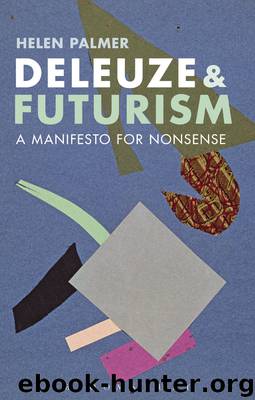Deleuze and Futurism by Palmer Helen;

Author:Palmer, Helen;
Language: eng
Format: epub
Publisher: Bloomsbury Publishing
The above description is Deleuze at his most Jakobsonian, and is extremely reminiscent of Jakobson’s famous statement that the ‘poetic function’ projects the principle of equivalence from the axis of selection into the selection of combination.22 It is helpful at this point to source this remarkable statement in Jakobson’s thought by breaking it down into its constituent parts and looking more closely at the axes of selection and combination. In Jakobson’s essay on aphasia he introduces the concept of the ‘twofold character of language’.23 In this passage Jakobson first presents two aspects of language as the concurrence of simultaneous entities and the concatenation of successive entities, but these are only one part of the two principal aspects of selection and combination. Concurrence and concatenation are both part of the combination, although – and this is one significant point where Jakobson departs from Saussure – he notes that Saussure only recognized the temporal sequence of concatenation and failed to take concurrence into account. Using selection and combination, then, Jakobson identifies two types of aphasia: the similarity disorder, which exhibits a deficiency in selection; and the contiguity disorder, which exhibits a deficiency in combination. His conclusion, then, maps these disorders onto the opposing linguistic tropes of metaphor and metonymy: ‘Metaphor is alien to the similarity disorder, and metonymy to the contiguity disorder.’24 We therefore have a string of related oppositional terms within Jakobson’s ‘bipolar structure’: one pole consists of selection, similarity and metaphor, whereas the other consists of combination, contiguity and metonymy. We can add to the list the axes of paradigm and syntagm, in which the former maps onto selection and the latter maps onto combination. It is important to point out, however, that again showing his proto-Deleuzian colours, Jakobson never loses a sense of fluidity of these oppositions under the schema of his poetic function. He maintains that in poetry, ‘where similarity is superinduced upon contiguity, any metonymy is slightly metaphoric and any metaphor has a metonymic tint’.25
In Deleuze’s account of creative stuttering, both linguistic axes are affected: the ‘disjunction of similars’, outlined above, as normal linguistic practice becomes a combination, and the ‘connection of combinables’ is divided. The stuttering is therefore a double stuttering. ‘Every word is divided, but into itself (pas-rats, passions-rations); and every word is combined, but with itself (pas-passe-passion).’26 The syntactic line that this type of language follows is described as a ‘syntax in the process of becoming’. It is not wholly outside of language, but the outside of language. This is the linguistic limit that links up Deleuze’s earlier term ‘sense’, discarded by this point in his career. This limit heralds a point where language transcends itself and tends towards another mode of expression altogether, and Deleuze is aware of this: ‘Words paint and sing, but only at the limit of the path they trace through their divisions and combinations.’27 It is this manipulation of spatiotemporal boundaries, the creation of new, impossible syntactic lines in order to transmute language, that Deleuze shares with the futurists.
Futurist
Download
This site does not store any files on its server. We only index and link to content provided by other sites. Please contact the content providers to delete copyright contents if any and email us, we'll remove relevant links or contents immediately.
| Anthropology | Archaeology |
| Philosophy | Politics & Government |
| Social Sciences | Sociology |
| Women's Studies |
The remains of the day by Kazuo Ishiguro(8397)
Tools of Titans by Timothy Ferriss(7817)
Giovanni's Room by James Baldwin(6812)
The Black Swan by Nassim Nicholas Taleb(6772)
Inner Engineering: A Yogi's Guide to Joy by Sadhguru(6444)
The Way of Zen by Alan W. Watts(6290)
Asking the Right Questions: A Guide to Critical Thinking by M. Neil Browne & Stuart M. Keeley(5358)
The Power of Now: A Guide to Spiritual Enlightenment by Eckhart Tolle(5335)
The Six Wives Of Henry VIII (WOMEN IN HISTORY) by Fraser Antonia(5239)
Astrophysics for People in a Hurry by Neil DeGrasse Tyson(5003)
12 Rules for Life by Jordan B. Peterson(4165)
Housekeeping by Marilynne Robinson(4068)
The Ethical Slut by Janet W. Hardy(4041)
Skin in the Game by Nassim Nicholas Taleb(3973)
Double Down (Diary of a Wimpy Kid Book 11) by Jeff Kinney(3930)
Ikigai by Héctor García & Francesc Miralles(3898)
The Art of Happiness by The Dalai Lama(3849)
Skin in the Game: Hidden Asymmetries in Daily Life by Nassim Nicholas Taleb(3727)
Walking by Henry David Thoreau(3685)
